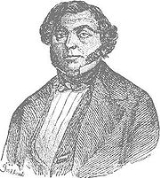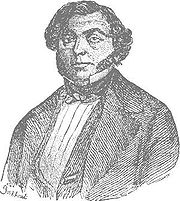
Eugène Sue
Encyclopedia
- "Marie Sue" redirects here. For the term in fan fiction, see Mary SueMary SueA Mary Sue , in literary criticism and particularly in fanfiction, is a fictional character with overly idealized and hackneyed mannerisms, lacking noteworthy flaws, and primarily functioning as a wish-fulfillment fantasy for the author or reader...
.

France
The French Republic , The French Republic , The French Republic , (commonly known as France , is a unitary semi-presidential republic in Western Europe with several overseas territories and islands located on other continents and in the Indian, Pacific, and Atlantic oceans. Metropolitan France...
novelist.
He was born in Paris
Paris
Paris is the capital and largest city in France, situated on the river Seine, in northern France, at the heart of the Île-de-France region...
, the son of a distinguished surgeon in Napoleon's army, and is said to have had the Empress Joséphine
Joséphine de Beauharnais
Joséphine de Beauharnais was the first wife of Napoléon Bonaparte, and thus the first Empress of the French. Her first husband Alexandre de Beauharnais had been guillotined during the Reign of Terror, and she had been imprisoned in the Carmes prison until her release five days after Alexandre's...
for godmother. Sue himself acted as surgeon both in the Spanish campaign undertaken by France in 1823 and at the Battle of Navarino
Battle of Navarino
The naval Battle of Navarino was fought on 20 October 1827, during the Greek War of Independence in Navarino Bay , on the west coast of the Peloponnese peninsula, in the Ionian Sea. A combined Ottoman and Egyptian armada was destroyed by a combined British, French and Russian naval force...
(1828). In 1829 his father's death put him in possession of a considerable fortune, and he settled in Paris.
A street in Paris is named for Eugene Sue, in the 18th Arrondissement: Rue Eugene Sue is located near the Poissonnière
Poissonnière (Paris Metro)
Poissonnière is a station on Line 7 of the Paris Métro. The station was opened on 5 November 1910. It is near the junction between the streets of Rue La Fayette and the Rue du Faubourg Poissonnière, after which it is named and along which fishmongers brought fish from Boulogne and other harbours...
Metro
Paris Métro
The Paris Métro or Métropolitain is the rapid transit metro system in Paris, France. It has become a symbol of the city, noted for its density within the city limits and its uniform architecture influenced by Art Nouveau. The network's sixteen lines are mostly underground and run to 214 km ...
station, and is not far from Montmartre
Montmartre
Montmartre is a hill which is 130 metres high, giving its name to the surrounding district, in the north of Paris in the 18th arrondissement, a part of the Right Bank. Montmartre is primarily known for the white-domed Basilica of the Sacré Cœur on its summit and as a nightclub district...
and the Basilica of the Sacré Coeur.
A street in Mexico City
Mexico City
Mexico City is the Federal District , capital of Mexico and seat of the federal powers of the Mexican Union. It is a federal entity within Mexico which is not part of any one of the 31 Mexican states but belongs to the federation as a whole...
, Calle Eugenio Sue, in the Polanco
Polanco
Polanco is the name shared by people and places in Mexico, Spain and other countries, including:* Polanco , an upscale neighborhood of Mexico City* Polanco, Cantabria, a municipality in Spain...
neighborhood, is also named for Sue.
Overview
His naval experiences supplied much of the materials of his first novels, Kernock le pirate (1830), Atar-Gull (1831), La Salamandre (2 vols., 1832), La Coucaratcha (4 vols., 1832-1834), and others, which were composed at the height of the Romantic movement of 1830Romanticism
Romanticism was an artistic, literary and intellectual movement that originated in the second half of the 18th century in Europe, and gained strength in reaction to the Industrial Revolution...
. In the quasi-historical style he wrote Jean Cavalier, ou Les Fanatiques des Cevennes (4 vols., 1840) and Lautréaumont (2 vols., 1837). His Mathilde (1841) contains the first known expression of the popular proverb "La vengeance se mange très-bien froide", lately expressed in English as "Revenge is a dish best served cold
Revenge
Revenge is a harmful action against a person or group in response to a grievance, be it real or perceived. It is also called payback, retribution, retaliation or vengeance; it may be characterized, justly or unjustly, as a form of justice.-Function in society:Some societies believe that the...
".
He was strongly affected by the Socialist ideas
Socialism
Socialism is an economic system characterized by social ownership of the means of production and cooperative management of the economy; or a political philosophy advocating such a system. "Social ownership" may refer to any one of, or a combination of, the following: cooperative enterprises,...
of the day, and these prompted his most famous works, the "anti-Catholic" novels: Les Mystères de Paris
Les Mystères de Paris
The Mysteries of Paris is a novel by Eugène Sue which was published serially in Journal des débats from June 19, 1842 until October 15, 1843. Les Mystères de Paris singlehandedly increased the circulation of Journal des débats...
(10 vols., 1842-1843) and Le Juif errant
Le Juif Errant
-Publication:Le Juif errant was a serially published novel, which attained great popularity in Paris, and beyond. According to historian John McGreevy, the novel was intensely and deliberately "anti-Catholic." Its publication, and that of its predecessor Les Mystères de Paris, greatly increased...
(tr. "The Wandering Jew
Wandering Jew
The Wandering Jew is a figure from medieval Christian folklore whose legend began to spread in Europe in the 13th century. The original legend concerns a Jew who taunted Jesus on the way to the Crucifixion and was then cursed to walk the earth until the Second Coming...
") (10 vols., 1844-1845), which were among the most popular specimens of the roman-feuilleton
Feuilleton
Feuilleton was originally a kind of supplement attached to the political portion of French newspapers, consisting chiefly of non-political news and gossip, literature and art criticism, a chronicle of the latest fashions, and epigrams, charades and other literary trifles...
.
He followed these up with some singular though not very edifying books: Les Sept pêchés capitaux (16 vols., 1847-1849), which contained stories to illustrate each of the Seven Deadly Sins
Seven deadly sins
The 7 Deadly Sins, also known as the Capital Vices or Cardinal Sins, is a classification of objectionable vices that have been used since early Christian times to educate and instruct followers concerning fallen humanity's tendency to sin...
, Les Mystères du peuple (1849-1856), which was suppressed by the censor in 1857, and several others, all on a very large scale, though the number of volumes gives an exaggerated idea of their length. Some of his books, among them Le Juif Errant and the Mystères de Paris, were dramatized by himself, usually in collaboration with others. Les Mystères was later plagiarized by Maurice Joly
Maurice Joly
Maurice Joly was a French satirist and lawyer known for his work titled The Dialogue in Hell Between Machiavelli and Montesquieu, later used as a basis for The Protocols of the Elders of Zion.-Life:...
. It is rumoured that Sue had a copy of the novel bound in the very skin of a woman who loved him - a most shocking example of anthropodermic bibliopegy
Anthropodermic bibliopegy
Anthropodermic bibliopegy is the practice of binding books in human skin. Though extremely uncommon in modern times, the technique dates back to at least the 17th century...
.
His period of greatest success and popularity coincided with that of Alexandre Dumas, père
Alexandre Dumas, père
Alexandre Dumas, , born Dumas Davy de la Pailleterie was a French writer, best known for his historical novels of high adventure which have made him one of the most widely read French authors in the world...
, with whom he has been compared. Sue has neither Dumas's wide range of subject, nor, above all, his faculty of conducting the story by means of lively dialogue; he has, however, a command of terror which Dumas seldom or never attained.
After the revolution of 1848 he sat for Paris (the Seine) in the Assembly from April 1850, and was exiled in consequence of his protest against the coup d'état
Coup d'état
A coup d'état state, literally: strike/blow of state)—also known as a coup, putsch, and overthrow—is the sudden, extrajudicial deposition of a government, usually by a small group of the existing state establishment—typically the military—to replace the deposed government with another body; either...
of 2 December 1851. This exile stimulated his literary production, but the works of his last days are on the whole much inferior to those of his middle period. Sue died at Annecy
Annecy
Annecy is a commune in the Haute-Savoie department in the Rhône-Alpes region in south-eastern France.It lies on the northern tip of Lake Annecy , 35 kilometres south of Geneva.-Administration:...
(Savoy
Savoy
Savoy is a region of France. It comprises roughly the territory of the Western Alps situated between Lake Geneva in the north and Monaco and the Mediterranean coast in the south....
) in 1857.
External links
- Wandering Jew and Wandering Jewess dramatic screenplay adaptations by Robert Douglas Manning ISBN 978-1-895507-03-4
- Works by Eugène Sue at Internet ArchiveInternet ArchiveThe Internet Archive is a non-profit digital library with the stated mission of "universal access to all knowledge". It offers permanent storage and access to collections of digitized materials, including websites, music, moving images, and nearly 3 million public domain books. The Internet Archive...
(scanned books original editions color illustrated) (plain text and HTML)

